
The Department of Mathematics Education

and to overlay several graphs of
for different values of a, b, or c as the other two are held constant.
From these graphs discussion of the patterns for the roots of
can be followed.
For example, if we consider the graphs of
for b = -3, -2, -1, 0, 1, 2, 3, and overlay the graphs, the following
picture is obtained.
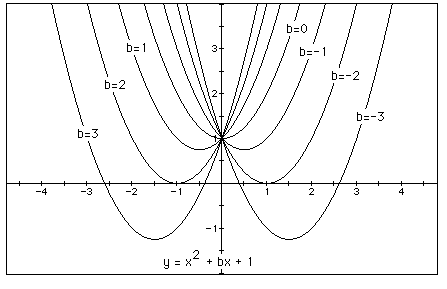
From this, we can discuss the "movement" of a parabola as b
is changed. The parabola always passes through the same point on the y-axis
( the point (0,1) with this equation). This point is known as the y-intercept.
It is found by setting x=0 and solving for y in all of the above functions.
By looking at the discriminant,
one can tell how many roots or x-intercepts exist. If the discriminant
is greater than 0, there will be two x-intercepts; equal to 0, one; and
less than 0; there will be no x-intercepts. In our above graph, for b <
-2 the parabola will intersect the x-axis in two points with positive x
values (i.e. the original equation will have two real roots, both positive).
For b = -2, the parabola is tangent to the x-axis and so the original equation
has one positive real root at the point of tangency. For -2 < b <
2, the parabola does not intersect the x-axis -- thus the original equation
has no real roots. Similarly for b = 2 the parabola is tangent to the x-axis
(one real negative root) and for b > 2, the parabola intersets the x-axis
twice to show two negative real roots for each b.
Now consider the locus of the vertices of the set of parabolas graphed from
The locus is the following parabola:
We can generalize this to be true because the vertex of this parabola
is the point (0,1), which is also the point in which the set of parabolas
all pass through.
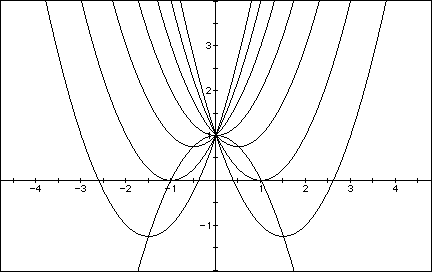
Consider again the equation
Now graph this relation in the xb plane. We get the following graph.
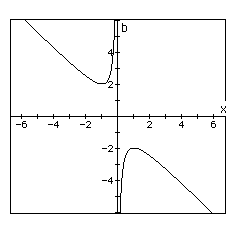
If we take any particular value of b, say b = 3, and overlay this equation
on the graph we add a line parallel to the x-axis. If it intersects the
curve in the xb plane the intersection points correspond to the roots of
the original equation for that value of b. We have the following graph.
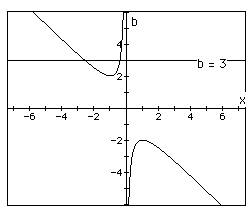
For each value of b we select, we get a horizontal line. It is clear
on a single graph that we get two negative real roots of the original equation
when b > 2, one negative real root when b = 2, no real roots for -2 <
b < 2, one positive real root when b = -2, and two positive real roots
when b < -2.
Consider the case when c = - 1 rather than + 1 in the above equation. We
get the following graph.

It is clear from this graph for any value of b that we pick we will get
two roots, one positive and one negative. It is also clear that zero will
never be one of the roots.
In the following example the equation
is considered. If the equation is graphed in the xc plane, it is easy
to see that the curve will be a parabola. For each value of c considered,
its graph will be a line crossing the parabola in 0, 1, or 2 points -- the
intersections being at the roots of the orignal equation at that value of
c. In the following graph, the graph of c = 1 is shown. The equation
will have two negative roots -- approximately -0.2 and -4.8.
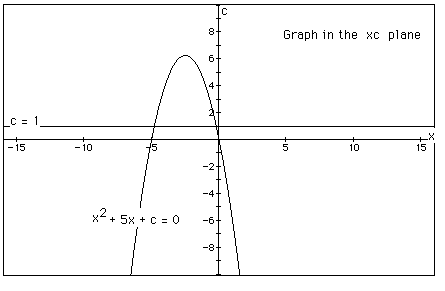
By looking at the graph, one can determine how many roots and the type
of roots the above equation will have according to whether c =0, c >0,
or c<0. There is one value of c where the equation will have only 1 real
root -- at c = 6.25. For c > 6.25 the equation will have no real roots
and for c < 6.25 the equation will have two roots, both negative for
0 < c < 6.25, one negative and one 0 when c = 0 and one negative and
one positive when c < 0.
What would the above graph look like if we let a=-1 instead of 1 in the
above equation? Let's see.

As one would expect, our findings are just reversed. Now for c<0 there
are two positive roots, for c>0 there is one negative and one positive
root, and for c=0 we have two real roots 0 and 5.